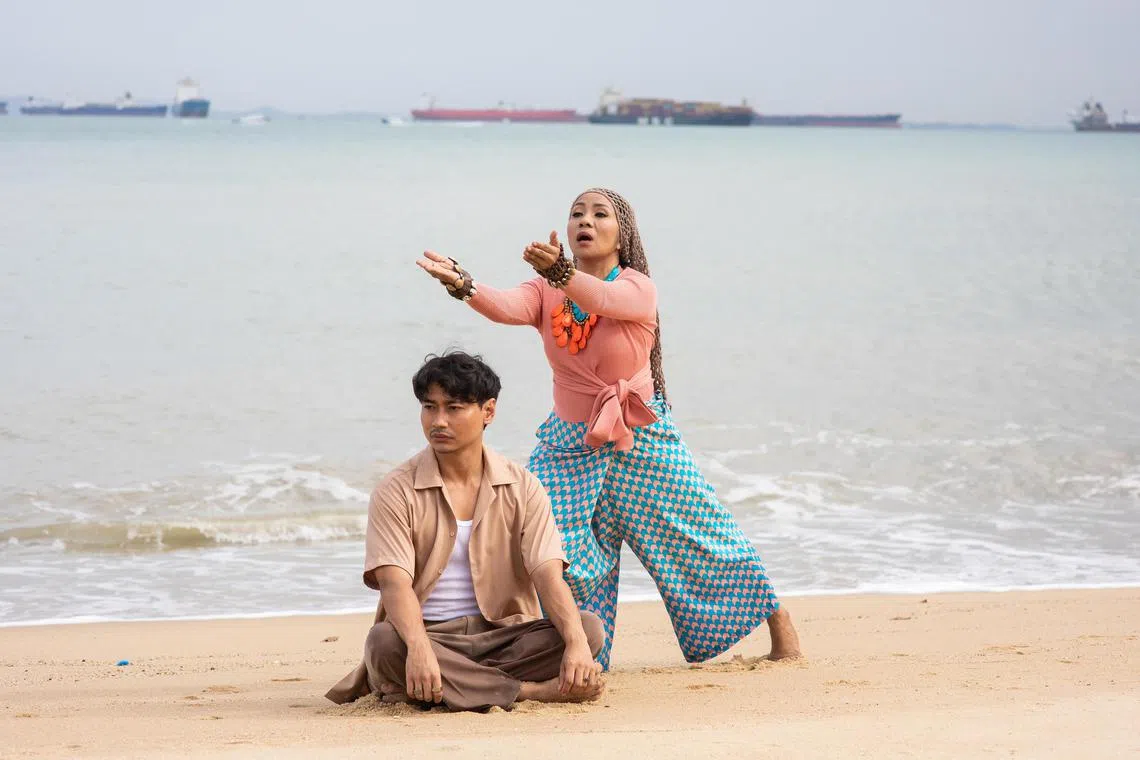Pesta Raya: Remembering Singapore’s disappearing south islander cultures in Air Da Tohor
Sign up now: Get ST's newsletters delivered to your inbox

Air Da Tohor, meaning "the tide is low", is the evocative title of one of the offerings at this year’s Pesta Raya.
PHOTO: AKBAR SYADIQ
Follow topic:
SINGAPORE – For Singapore’s southern islanders, Air Da Tohor (“the tide is low”) is a vernacular expression full of possibilities.
The receding of the sea reveals a hidden layer of sustenance and rich biodiversity. Low tide is also a time when jetties and stilt houses extending far into the water are built – not a retreat, but a state bustling with activity and life.
Carefully chosen by two descendants of Singapore’s orang pulau and orang laut, Asnida Daud and Firdaus Sani, it is the evocative title of one of the 2023 offerings at Pesta Raya
The 1½-hour showcase is an achronological, multidisciplinary presentation that blends spoken word with movements drawn from islander rituals, hoping to renew interest in a fast-disappearing culture once indigenous to Pulau Semakau, Pulau Seking and Pulau Sudong, among others.
Poet and actress Asnida, 50, says: “Air Da Tohor is used among peoples of the sea. In other cultures, there might be an association with regression. But for us, it is the total opposite. You are exposing shellfish, crabs and so on, and life goes on. Low tide, in a way, is also high.”
The performance, held at the Esplanade Recital Studio, is threaded through with Asnida’s poems, repetitive movements like the weaving of Bubu traps used to trap fish, and multimedia filmed by Asnida’s 20-year-old son along the west coast – where islander traditions are still quietly practised.
It is split into four sections, putting on stage practices that have so far been mostly kept within the dwindling community: animistic healing and love mantras (mantera laut), maritime craftsmanship (rangka bubu, rangka budaya), food gathering (kami tak akan mati) and the islanders’ role as guardians of nature (pelindung).
Firdaus, 34, says the abjuring of conventional narrative is because the rhythms of ritualistic practices are important for the power of islander cultures to be felt. “The spaces that we want to explore, such as mantras, are very haunting. Summoning these, and the idea of manifestation and other intangible parts of our culture, can be seen only through a spoken-word setting.”
The founder of Orang Laut SG, a page dedicated to reclaiming indigenous narratives, says it is also a more poignant mode of conveying loss, which is a big part of modern islander sensibility. This spans the domains of language, indigenous spaces and skills such as how to remove poison from puffer fish.
“It’s a measure of our culture, leading into how the country sees us, how we are always placed at the peripheries of Malay subculture,” adds Firdaus.
Asnida and Firdaus started working together three years ago, after a meeting which Asnida describes as “love at first sight”.
Both spent their formative years close to the Southern Islands. While Firdaus’ classmates were hankering after the latest Tamagotchi, he was out racing dolphins near the Riau Islands.
He was also an avid collector of buntat ikan, colourful stones that can be found in the innards of large fish, which he would catch with his grandfather – who is also known as something of a fishing savant in Pulau Semakau.
Asnida’s reckoning with her own culture was much more recent. When she was younger, she found her family’s weekly visits to Pulau Sudong a chore, and would return to the mainland tanned and feeling inferior.
Islander children in her primary school were treated differently and had a reputation, even among kids, for being naughty, despite a grudging recognition that they were good sportsmen.
“It’s a labelling thing. My relationship with the islands later changed. I started to become more introspective. If I don’t do this, I’ll lose my own culture,” she says.
Asnida hopes that through the performance, the cadence of islander’s speech – a particular way of speaking which her children thought was singing – will be given more exposure.
And Firdaus speaks of portals to another world. “There are sacred spaces on the various islands. A tree on Pulau Semakau is thought to be a portal to the orang bunian (hidden people of Malay folklore).
“We need to acknowledge such spaces when we look into development of the maritime space or the island itself. We need to consult the people who use them. When you go into someone’s house, you respect their home.”
Book It/Air Da Tohor
Where: Esplanade Recital Studio, 1 Esplanade Drive str.sg/i4LF
When: May 19, 8pm
Admission: Tickets from $30
Info:


